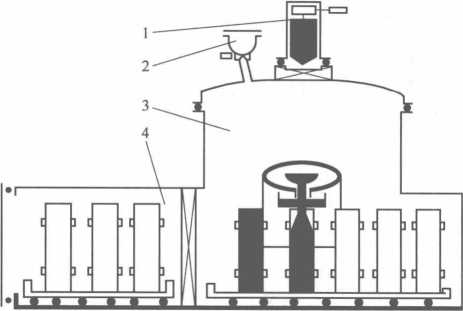- 05
- Sep
Composition and classification of vacuum induction furnace
Composition and classification of vacuum induction furnace
Structure of vacuum induction furnace
Vacuum induction furnace is mainly composed of the following parts: induction furnace body (including melting device), vacuum system, power supply device, water cooling system, hydraulic system, pneumatic system, electrical control system, and intermediate frequency power supply. The structure of a traditional vacuum induction furnace is shown in Figure 5-1.

Figure 5-1 Traditional vacuum induction furnace
1—Main feeding room; 2—Alloy feeding room; 3—Smelting room; 4—Ingot room
There are induction coils, water-cooled power supply cables, hydraulic tilting furnace cylinders, and mold car in and out transmission devices installed in the melting chamber. There is a large door between the ingot room and the smelting room, commonly known as the inner door, which separates the smelting room from the ingot room. The mold ingot chamber is equipped with an outer door, and the mold car is operated in and out by opening and closing the inner and outer doors to maintain the vacuum of the melting chamber and realize semi-continuous steelmaking. The main feeding chamber and the alloy feeding chamber are also separated from the smelting chamber by valves, so that the vacuum of the smelting chamber is not damaged when feeding. Traditional vacuum induction furnaces have a very large melting chamber. For example, a furnace with a capacity of 5t has a melting chamber volume of 60m3. Even so large, its internal maintenance is very difficult and operating costs are very high (mainly oxygen consumption). The mold room is determined by the number and arrangement of the spindles, and it is generally difficult to shrink. The volume of the vacuum induction furnace mold ingot chamber is determined by the furnace capacity, the number of spindles required by the user, the diameter and the length, and it is difficult to reduce it.
